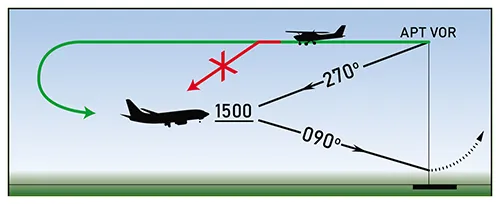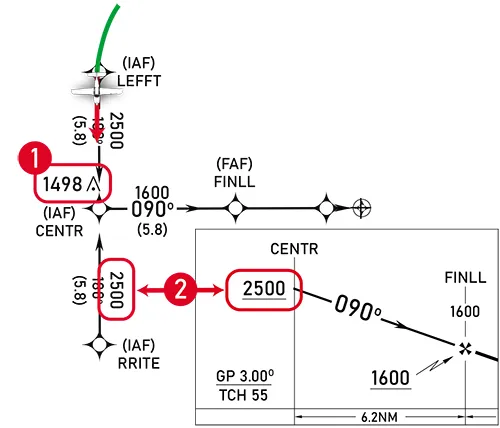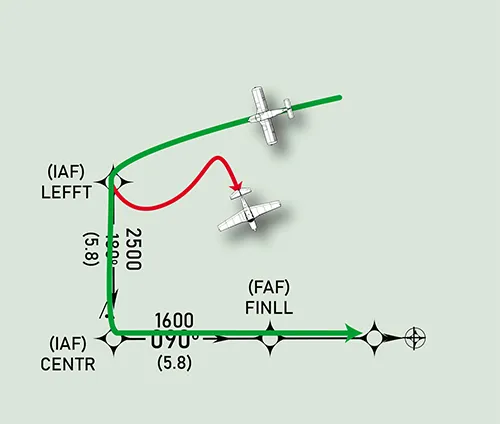Sequences don’t come much easier. A VFR Mooney and a VFR Cherokee both requested a practice RNAV approach. They were the same distance from the same initial approach fix (IAF), and the Mooney was 50 knots faster than the Cherokee.
I gave the Mooney direct to the IAF. The slower Cherokee got a few vectors to fall in trail, then also got direct to the IAF. With all the sequences I build every day as a controller, this was a no-brainer. Fast guy in front. Slower guy in the back.
Yet mere minutes later, both would be head-on with a 250-knot closure, and I’d be barking, “Turn right immediately!” while feeling a chill down my spine.
What happened? It was an incorrect assumption about some unfamiliar phraseology. How often do serious consequences spring forth from simple misconceptions? Unfortunately, more often than you think.
Expecto Approachus
To clear both aircraft for the RNAV approach, I must ensure they’re separated by at least three miles. Even under VFR, an approach clearance is an instrument procedure. It magically creates a temporary requirement for increased spacing between the aircraft cleared for an approach, regardless of whether they’re initially VFR or IFR.
Initially, I only had 2.5 miles. But with the speed differential, that would gradually increase to over three. So, I told the Mooney, “Proceed direct LEFFT (the left IAF), join the final approach course inbound. Maintain 2500.” What does that mean? What did I expect?
An instrument approach is a route defined by fixes, waypoints, altitudes, and/or navaid radials. I expected him to fly that path, inbound, as if he was doing the approach, but holding the assigned altitude. In this case, overfly LEFFT, then turn towards CENTR, eventually hooking inbound towards the final approach fix (FAF), all at 2500.
This is a common instruction when ATC is waiting for a requirement to be met. In this case, I was waiting for that three miles. Once I had that distance, I could clear him for the approach and he could descend on the approach.
Well, the Mooney hit LEFFT, and turned left, but kept turning, swinging all the way around, directly toward the Cherokee. I went from 2.5 miles increasing to three, to one mile rapidly diminishing to “swapping paint.” I called the Mooney. “Turn right immediately!” giving him a 90-degree turn away from the Cherokee, and exchanged traffic information between the two.
After the dust settled and I’d uttered some off-mic bleepable language, I asked the Mooney pilot what he was doing. He responded, “I wasn’t sure. I thought you wanted me to overfly the IAF and go back out, like a hold.” I was dumbfounded. He had no idea what “join the final approach course inbound” meant. Instead of asking me to clarify, he nearly bought himself and another planeload of people a really bad day.
The lesson here is if you’re unsure, ask the controller what they want you to do. There’s a lot of phraseology out there, some of which could be unfamiliar. Blindly reading back instructions without comprehending their meaning leaves both you and ATC in the dark. If you need help or clarification, please ask.
One Does Not Equal the Other
Assumptions and misconceptions in the vertical are just as bad. Another day, I had a Cessna Skyhawk at 3000, requesting a VOR approach with a procedure turn. The VOR itself was located on their destination airport. Its final approach course rode outbound and the procedure turn typically occurred about five miles from the VOR itself. At the time, I also had a Boeing 737 inbound, descending to 1500, who was going to be first.

I instructed the Skyhawk, “Proceed direct the VOR, join the final approach course outbound. Maintain 3000.” My plan? The IFR Boeing would be straight in on the final. The IFR Skyhawk was going to hit the VOR and fly the approach’s outbound course, maintaining 3000 until advised, above and opposite direction to the Boeing. Once they’d crossed and I knew I had spacing, I could clear the Skyhawk for the approach, and he could descend and make his procedure turn to fall in behind the 737.
Due to the Boeing’s position, I couldn’t allow the Skyhawk to start a procedure turn at the normal point. I told him, “I’ll call your procedure turn.” He read it back and continued outbound.
Suddenly, he started descending out of 3000 … head on with the Boeing still two miles ahead. I caught it when he was through 2700 feet. “Climb immediately,” I barked, “and maintain 3000.” Thankfully the Boeing was already dropping out of 1500 feet, so I didn’t lose my 1000 feet of required vertical separation.
What was the Cessna driver thinking? “I thought we were cleared for the approach when you said you were going to call our procedure turn.” I confirmed I said I’d call the procedure turn, but pointed out he’d only been told to fly the outbound course at 3000, with no approach clearance. Adding another instruction didn’t negate the original.
The takeaway: When flying a final approach course, all prior altitude restrictions apply until you hear “cleared approach.” Only then can you descend to the appropriate altitude for the segment of the approach (or any newly assigned altitude or crossing restriction). His assumption could’ve caused an airliner filled with passengers to take sudden evasive maneuvers, hurting someone.
Dumping Ground
To be clear, if you’re told “join the final approach course,” maintain the last assigned altitude until cleared for the approach, while flying the approach lateral guidance. Once ATC says “cleared approach” and doesn’t give you any further altitude restriction, you can descend to the appropriate altitude on the approach. Note that word: appropriate.
There’s a reason approaches have altitude restrictions. The Earth below and the structures on it aren’t endless seas of flat land. Obstacles like mountains, antennas, buildings, and other hazards can hurt you badly.
I recently had a Cirrus inbound to a non-towered airport for an RNAV approach. I told him to proceed direct to the RRITE IAF, maintain 2500 feet—the IAF altitude—and then “join the final approach course and report established.” Meanwhile, I handled other traffic. Eventually, he hit the IAF and reported established on the course. At that point, I said, “Cleared approach.”
I typically wait until an aircraft has hit CENTR before changing them to advisory frequency. Good thing. Instead of staying at 2500 feet between RRITE and CENTR, the Cirrus suddenly plunged downwards … directly at a 1498-foot antenna between the two IAFs. I cancelled his approach clearance and told him to climb immediately to 2500 feet.

When asked, he said he was, “Just descending to the final approach fix’s altitude.” The FAF is at 1600 feet— a scant 102 feet above the antenna. He’d apparently forgotten the content of AIM 5-4-5, paragraph b, no. 1: “Minimum altitude will be depicted with the altitude value underscored. Aircraft are required to maintain altitude at or above the depicted value, e.g. 3000.”
The 2500 on the approach chart’s profile had an underline, and it certainly had it for a reason: to keep him 1000 feet above that antenna. Only upon crossing CENTR—i.e. safely past the antenna—could he legally begin the descent to the FAF’s 1600. Ignoring that restriction plummeted him directly into harm’s way.
This should serve as a reminder: Receiving an approach clearance once you’re established on the approach doesn’t release you from the altitude restrictions on the approach. Failing to comply with them could put you in danger, as almost happened with this pilot. It was IMC and if he’d been 102 feet off on his altitude, he likely would never have seen the antenna—until it was too late.
Procedure turns are standard features of many instrument approaches. However, they add complexity and unpredictability to ATC’s sequence, since the time to make the turn can vary a lot depending on an aircraft’s speed and the depicted turn itself.
For our traffic flow, we often have to disallow procedure turns from aircraft intercepting the final at less than a 90 degree angle. This is specifically addressed in FAA Order 7110.65’s Approach Clearance section, 4-8-1 e.: “If a procedure turn, hold-in-lieu of procedure turn, or arrival holding pattern is depicted and the angle of intercept is 90 degrees or less, the aircraft must be instructed to conduct a straight-in approach if ATC does not want the pilot to execute a procedure turn or hold-in-lieu of procedure turn.”
That would typically be phrased, “Four miles from CENTR. Proceed direct CENTR. Cross CENTR at 3000. Cleared straight in RNAV runway 9 approach.” No PT. Just join the final at the IAF and fly the approach. Listen for that “straight in” part. It’s crucial.
On several occasions, however, I’ve had pilots I’d cleared for the “straight in” approach—and read back as such—suddenly do the course reversal for the PT. They either forgot or didn’t understand what was intended. This has resulted in them turning in the face of following traffic—not good—and a whole lot of ensuing vectors to pry everyone apart.
If there’s any doubt as to whether ATC wants that PT, ask. Listen for clues. For instance, if you’re on a good intercept angle for the IAF (less than 90 degrees), hear aircraft being vectored behind you, and, on your clearance, ATC forgets to say “straight in”, that’s the time to inquire, “Do you want me to do a procedure turn?” —TK
May I Cut In?
During my time as a controller, I’ve been continually amazed by the creative ways in which certain pilots interpret ATC instructions. Some “What the heck is that guy doing?” moment is always lurking around the corner. It keeps me on my toes.
We’ve discussed course and altitude expectations. However, we haven’t touched on speeds. If I’ve got a jet or turboprop following a slower fellow, it’s common for both aircraft to get speed instructions. Controllers are well aware that Cessna Skyhawks, Piper Cherokees, and other light props can only pedal so fast, but even a difference of 5 knots or 10 knots can help us out. Likewise, we know turboprop/jet aircraft can only go so slow.
When a slow guy’s leading the pack, they’ll commonly be told, “Maintain maximum forward speed.” Now, per the regulations—FAA Order 7110.65 5-7-1 (b) (4), to be exact—ATC can only expect a pilot to maintain an assigned speed until either a five mile final or the final approach fix (whichever comes last). Afterwards, the pilot can resume normal approach speed.
Even though the five miles/FAF cutoff is implied, oftentimes, for clarity, ATC will still include it. “Maintain maximum forward speed until five-mile final” or “…until the final approach fix.” Yeah, it’s redundant, but it helps get the point across to less experienced pilots: I need you to go fast to that point.
One flight-training Piper Cherokee requested an RNAV approach via LEFFT. He was following another aircraft, and leading a pack of faster planes. “Cross LEFFT at [altitude]. Cleared RNAV approach Runway 9. Maintain maximum forward speed until the final approach fix.” He read it back perfectly and I went about my other business. Our friend in the Piper poured on the gas and went direct LEFFT as instructed.
He overflew LEFFT, then hooked directly at the final approach fix, bypassing CENTR. He assumed “maintain maximum forward speed to the final approach fix” meant turning directly at the FAF instead of flying the complete approach course. Now he was converging with the preceding aircraft. I caught it, cancelled his approach clearance, and revectored him to intercept via CENTR instead. I also had to revector some of the aircraft trailing him, to allow for the jog he’d taken. The craziest thing to me was that there was a flight instructor onboard, who let his student turn towards the FAF and either didn’t correct him, or didn’t notice. Either way, it makes you wonder…
Many of these situations might leave you shaking your head, feeling somewhere on the spectrum between horror, disbelief, and amusement (after everyone landed okay). I won’t speak to the legal outcome of these specific cases, but I have seen pilot deviations filed for situations like these, especially when they result in a loss of required separation.
What is the common element here? Each pilot read back their instructions perfectly … but they didn’t comprehend their meaning, were unfamiliar with the phraseology, or made incorrect assumptions. The ultimate lesson is: If you’re not completely sure about something, for your own safety’s sake, please ask. That’s not just common sense. It’s in the regs. 14 CFR Section 91.123: “When a pilot is uncertain of an ATC clearance, that pilot shall immediately request clarification from ATC.”





